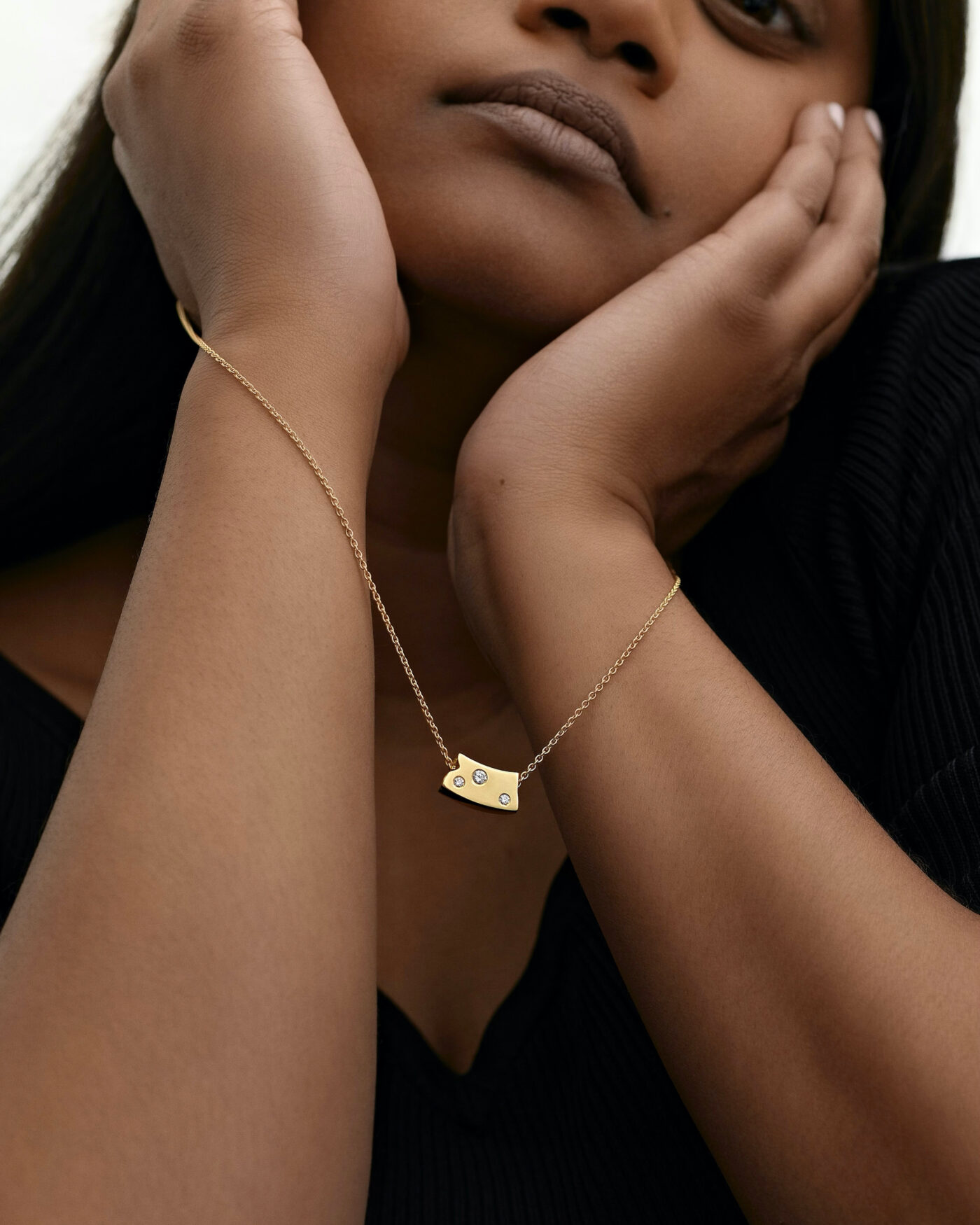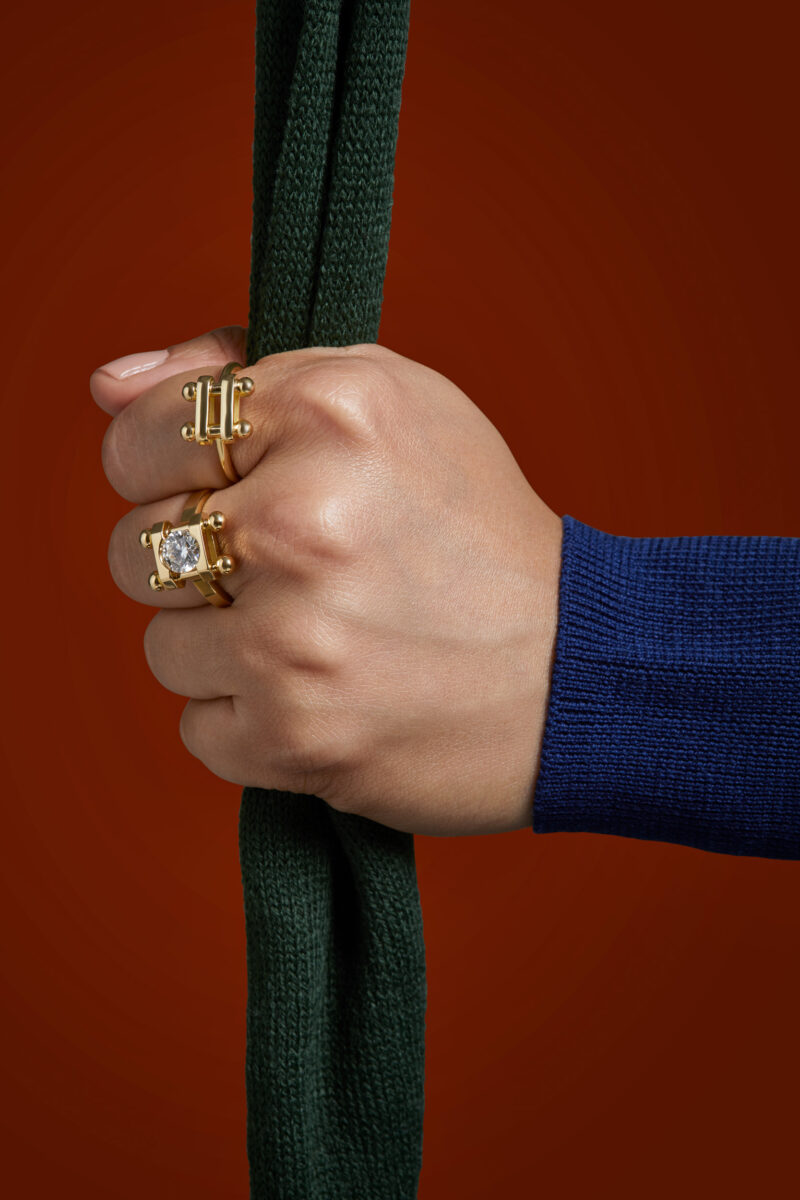NFT Jewelry – A fundamental change is happening at the very core of the jewelry field– a new generation of designers, craftspeople, and collectors are diving into technologies such as Blockchain and Non-Fungible Tokens (NFTs). But where does this seemingly un-correlated and highly disruptive technology fit within the jewelry industry, and how do jewelers, large and small, intentionally incorporate it into their work?

Independent NFT Jewelry
Award-winning, independent designer Simone Faurschou, who participated in our 2022 digital panel, “What Does Web3 Mean for Jewelry?” was one of the early adopters of NFT technology in the jewelry industry. Renowned for highlighting the contrast between chaos and order in nature and the interaction with the man-made world, Faurschou created a collection of necklaces titled “Blockchain,” that focussed on NFT education through physical representation.

Her NFTs are digital works of art, a unique video animation depicting a circle of individual blocks in yellow/white gold with diamonds, breathing in and out against a natural backdrop. Hosted on the NFT platform and market, KnownOrigin, once purchased, the collector is shipped a physical pendant crafted in 18-karat, FairMined gold, accented with lab-grown diamonds. This unique approach of bridging the natural and human-made world to her collectors not only aids in better understanding the NFT and Blockchain tech but also gives the collector a one-of-a-kind jewel to enjoy their acquisition daily.

An approachable, self-created, and thoughtful collection crafted of ethically concious materials, I believe Faurschou’s take is a prime example of how an independent artist can integrate NFT technology with jewelry. Attracting and inducting a passionate group of collectors, Faurschou should be watched closely as an industry leader working in Blockchain as she ramps up her collections.
Striking While Hot
From independent jewelers to major powerhouses, many are bringing their own take to the unique world of blockchain. Tiffany & Co. is no exception.
Through the release of Tiffany’s hyper-exclusive “NFTiff” pendant collection, Senior Vice President of Product and Communications Alexandre Arnault, aged 30, has turned Tiffany to appeal to a younger and more tech-savvy generation than what the iconic jeweler has traditionally been associated with. Playing on the “hype factor” that has led fashion brands like SUPREME to enormous success, Tiffany collaborated with CryptoPunk, an early and popular 8-bit NFT, creating 250 limited-edition jewel-encrusted pendants. Priced at 30ETH (at the time of release, about 50,000 USD), the collection sold out in less than 20 minutes, even with a requirement that a buyer owns a CryptoPink NFT at the time of purchase.

What’s important to understand about Tiffany’s take on NFT jewelry is the rights you receive when purchasing an NFT. When you buy an NFT, you buy the Intellectual Property (IP) and rights to a digital work of art. In essence, when Tiffany offered the NFTiff collection, the participants were licensing Tiffany to create a physical good from their IP. The rights of creating, owning, and arguably even wearing the newly minted CryptoPunk pendant lie with the current owner of that specific NFT and nobody else. If you sell the NFT, you’re selling the rights and property of the pendant, and all future works derived from it, adding another layer of perceived value to your digital property. But is this value real? Does it hold its value? And, does Tiffany’s model make sense for a smaller, independent jeweler?
With recession worries, looming government regulations, and numerous high-profile crypto-firm bankruptcies and lawsuits coming into play, I feel consumers are losing trust in the conglomerate NFT and Blockchain system and rethinking their approach to such high-profile, expensive, and experimental acquisitions.
Strictly based on monetary value, the price of the Tiffany & Co. pendant today (30 ETH) would be valued at about 54,000 USD; however, this price has fluctuated violently over the past year, with potential losses reaching up to 12,000 USD on paper. While we haven’t seen the sale of an NFTiff pendant (and corresponding NFT) to show how these values hold up, or if they even will, it will be something to keep a close eye on.

Tiffany capitalized on a hot trend that struck gold for them at the height of the NFT craze, but they have the marketing dollars, financial backing, and large client base to ensure its success and, worse case, keep the lights on should it have proved to be a flop. However, independent makers rarely, if ever, have this safety net, and collectors seeking out an independent maker’s work usually want to acquire a unique vision and expression of their world– not another artist’s work re-interpreted into precious materials. Given the Blockchain and economic turbulence we are seeing, it may best to stay clear of this method unless you have an NFT-curious client base, alongside the time and resources to spend experimenting with possible directions and artistic collaborations.
No Fakes For You
From Haute Joaillerie to Haute Horlogerie, the siren call of Blockchain tech doesn’t cease. Bvlgari’s Octo Finnisimo, the world’s thinnest watch at the time of its release, debuted how NFT and Blockchain tech could upset and secure the timekeeping and precious material realms.
Wound by a small wheel on the side, the dial showcased a unique QR code laser engraved on the stainless steel ratchet seated within the exposed skeleton movement. When scanned, the QR code directs the user to a digital experience– transporting you through the history of timekeeping and allowing you access to an exclusive NFT.

There is a key difference between how Bvlgari and Tiffany & Co. use Blockchain tech in their jewels. Like Tiffany’s pendants, the Finnisimo is tethered to an exclusive NFT. However, it wasn’t birthed from this NFT. So what could its purpose be beyond a conversation starter? Authentication and proof of ownership.
For decades, no matter how exclusive or rare a timepiece is, the watchmaking community, particularly the Swiss watchmaking community, has been plagued by counterfeit goods. Speaking with first-hand experience from my five years at a Pawnbroker, I can attest to the level of detail these counterfeits have developed, to the point where the counterfeit and the authentic watch, even held side by side, are nearly indistinguishable from one another. While watchmakers have done their best to implement certain security features into their dials, cases and serial numbers, counterfeiters seem to be consistently hot on their heels with a response. By integrating an NFT into the watch dial, Bvlgari can tether the ownership and authentication of the watch in a similar way to Tiffany’s pendants.

So, what bearing does this concept have on the wider jewelry field? A similar adaptation of NFT and Blockchain tech could aid in further securing and streamlining the third-party authentication and auditing of FairTrade, FairMined and recycled precious metals. You could also push this tech even further by integrating it into GIA (and the like) reports, allowing for more consumer transparency and confidence when making acquisitions. The possibilities and benefits are endless.
The Big .JPG
This all said, we’re still very much in the early days of NFT technology, and whether it finds bearing in the industry or not is yet to be shown. However, right now, you can either demand or reject it. But, as always, stay true to yourself, your core beliefs, and your creative vision when forging your path forward.
Editorial written and laid out by Future Heirloom Editor, Nicholas Hyatt; Find Nicholas at his site Ping Pong Ring and @ping_pong_ring.








